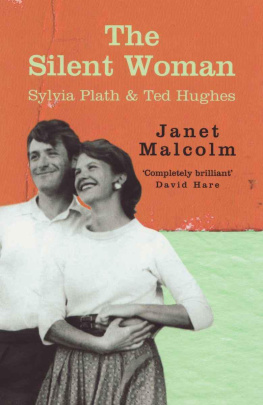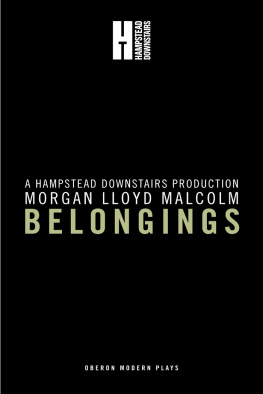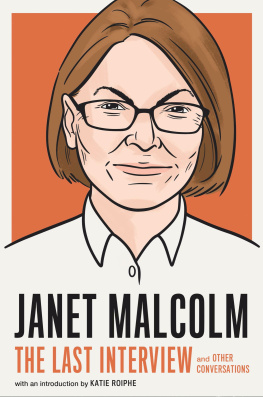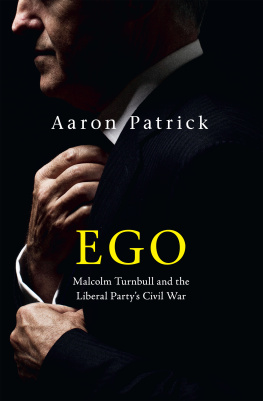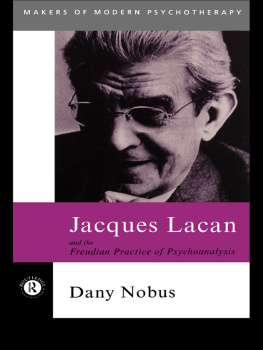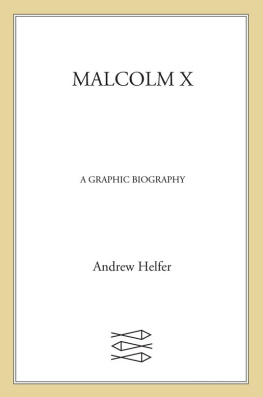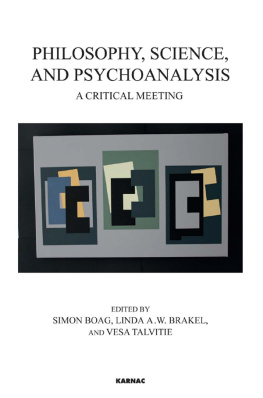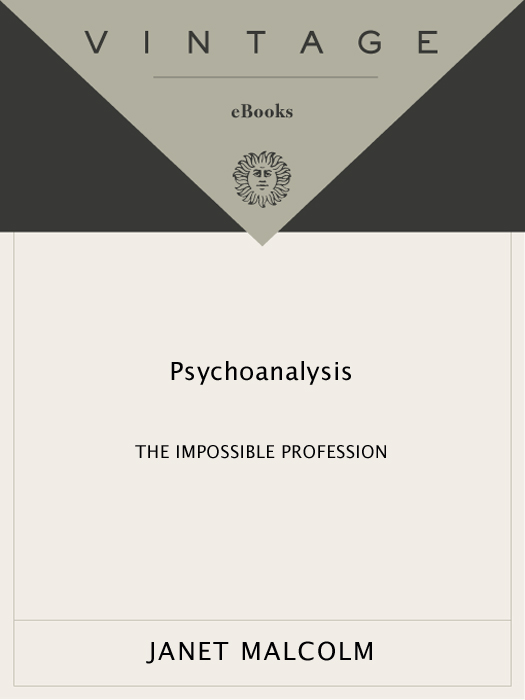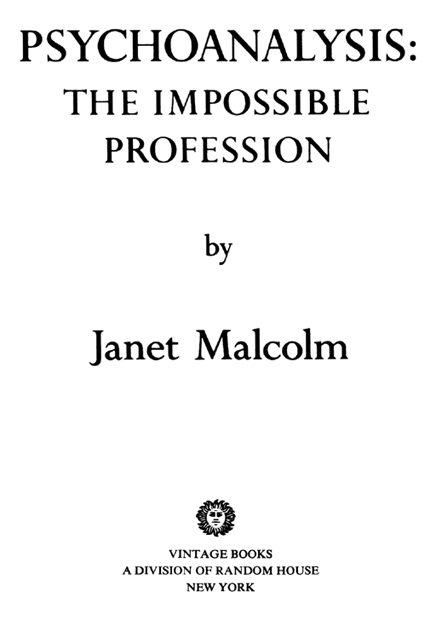Copyright 1980, 1981 by Janet Malcolm
All rights reserved under International and Pan-American
Copyright Conventions. Published in the United States by Random House, Inc., New York, and simultaneously in Canada
by Random House of Canada Limited, Toronto. Originally
published by Alfred A. Knopf, Inc. in 1981.
Most of this book was first published in The New Yorker.
Library of Congress Cataloging in Publication Data
Malcolm, Janet.
Psychoanalysis: the impossible profession.
Most of this book was first published in the New Yorker
Reprint. Originally published: New York: Knopf, 1981.
Bibliography: p.
1. Psychoanalysis. 2. Psychoanalysts. I. Title.
RC 506.M283 1982 616.89023 82-4871
eISBN: 978-0-307-79783-4 AACR 2
v3.1
To my father
Contents
It almost looks as if analysis were the third of those impossible professions in which one can be sure beforehand of achieving unsatisfying results. The other two, which have been known much longer, are education and government.
SIGMUND FREUD ,
Analysis Terminable and
Interminable (1937)
As psychoanalysts, we are only too aware that our profession is not only impossible but also extremely difficult.
ADAM LIMENTANI ,
International Journal of Psycho-Analysis (1977)
If two people are repeatedly alone together, some sort of emotional bond will develop between them.
PHYLLIS GREENACRE ,
Journal of the American
Psychoanalytic Association (1954)
The soul God gave me isnt of the sort
That prospers in the weather of a court.
Its all too obvious that I dont possess
The virtues necessary for success.
My one great talent is for speaking plain;
Ive never learned to flatter or to feign;
And anyone so stupidly sincere
Had best not seek a courtiers career.
MOLIRE , The
Misanthrope, translated by
Richard Wilbur
Acknowledgements
I AM DEEPLY INDEBTED TO DANIEL SCHWARTZ, DIRECTOR OF the Austen Riggs Center, who encouragedno, incitedme to write the article that forms the basis of this book, then patiently read the manuscript to rid it of many errors, and, above all, kept me on course in my writing and thinking through his embodiment, in my imagination, of the ideal of analysis. I am grateful to many other psychoanalysts who generously gave of their time to discuss the profession and the theory of psychoanalysis with me. Thanks also are due to the New York Psychoanalytic Institute for placing its incomparable library at my disposal; to the staff of the library for kindly assisting The New Yorkers checking department; to Nancy Franklin, of the checking department, for her outstanding, elegant work; to Elizabeth Kramer for her illuminations of many koans of psychoanalytic theory and practice; to Hartvig Dahl and Virginia Teller for the immense intellectual stimulation and personal kindness I received from them; to Peter Gay for his astute and most valuable criticisms and suggestions; and to Marianka Vynov-Mueller for her assistance beyond the call of duty in the basement of the Albrecht Mueller Rat Man Archive. Above all, I thank and salute, Aaron Green, the remarkable and lovable man who opened his mind and heart to me and gave this book its life.
1
A ARON G REEN (AS I SHALL CALL HIM) IS A FORTY-SIX- year-old psychoanalyst who practices in Manhattan, in the East Nineties. He has four patients in analysis, who come four or five times a week and lie on the couch, and six patients who come for psychotherapy once or twice or three times a week and sit in a chair. He charges between thirty and seventy dollars per (fifty-minute) hour. He is on the faculty of a local medical school, where he teaches and supervises medical students and psychiatric residents. He is a graduate of the New York Psychoanalytic Institute and a member of the New York Psychoanalytic Society. He came to New York to study at the Institute after getting his medical degree and serving his internship and residency in a New England city.
He is a slight man, with a vivid, impatient, unsmiling face. He has thin dark hair and wears professorial clothes. A herringbone jacket, light-blue oxford shirt, subdued tie, and gray flannel trousers are his customary apparel. He looks Jewish. He lives with his wife and son in a brownstone apartment off Madison, four blocks from his office. The living room of his apartment is furnished with black modern sofas and armchairs, beige carpets, reproductions of modern art, photographs, folk art and archeological objects, and books; it is spare, extremely neat, pleasant, perhaps a hair studied. His consultation room is a kind of poor relation of his living room. The couch is fifties Scandinavian modern rather than seventies high-tech Italian; the pictures are old MOMA reproductions rather than Fondation Maeght exhibition posters; there are floor lamps instead of track lighting. The lights in the consultation room are kept dim, purposely.
The psychoanalysis that Aaron Green practices is of the most unswervingly classical Freudian sort. His thinking about theory and technique has been shaped by Charles Brenner, the intransigent purist of American psychoanalysis, author of a forbidding Elementary Textbook of Psychoanalysis and, with Jacob Arlow, of Psychoanalytic Concepts and the Structural Theory, a once controversial, now standard advanced text. Brenner is known for his advocacy of a fanatically meticulous, aseptic analytic technique and for his hard-line theoretical position, which goes from Freud through the ego-psychology triumvirate of Heinz Hartmann, Ernst Kris, and Rudolph Loewenstein to the culminating quartet of himself, Jacob Arlow, Martin Wangh, and David Beres. Green is contemptuous of most recent developments in psychoanalysis, dismissing them as fads. He is unimpressed by the French structuralist psychoanalyst Jacques Lacan, whose impenetrably obscure writings have been gaining increasingly earnest attention here, but whose innovation of reducing the fifty-minute analytic hour to a Delphic seven or eight minutes (or sometimes even to a single oracular parole murmured in the waiting room) has yet to be adopted. He is similarly skeptical of the new theories of Heinz Kohut and Otto Kernberg, derived from work with narcissistic and borderline disorders; the stir that Kohut (who is the center of a fervid cult in Chicago) and Kernberg (who works in New York and has a quieter following) have been making within and outside the field fills him with disgust. The English object-relations people (D. W. Winnicott, W. R. D. Fairbairn, Michael Balint, Harry Guntrip, and others), who predate and foreshadow the Kohut and the Kernberg groups, are equally wrong-minded, he feels. When the name Melanie Klein is uttered, he closes his eyes and groans softly.
Green is critical of his own work. He feels it is good, but not as good as it will be when he has had more experience. He looks back on past cases with misery and guilt over blunders he has made. When a patient gets better, Green credits the psychoanalytic process; when he doesnt, he blames himself. He has been doing analysiscounting the years of work he did under supervision during his training at the New York Psychoanalytic Institutefor more than a decade. He was in analysis himself, with two analysts, for a total of fifteen years. The first analysis began while he was in medical school and lasted for six years; the second was his training analysis at the Institute, which lasted for nine years.



